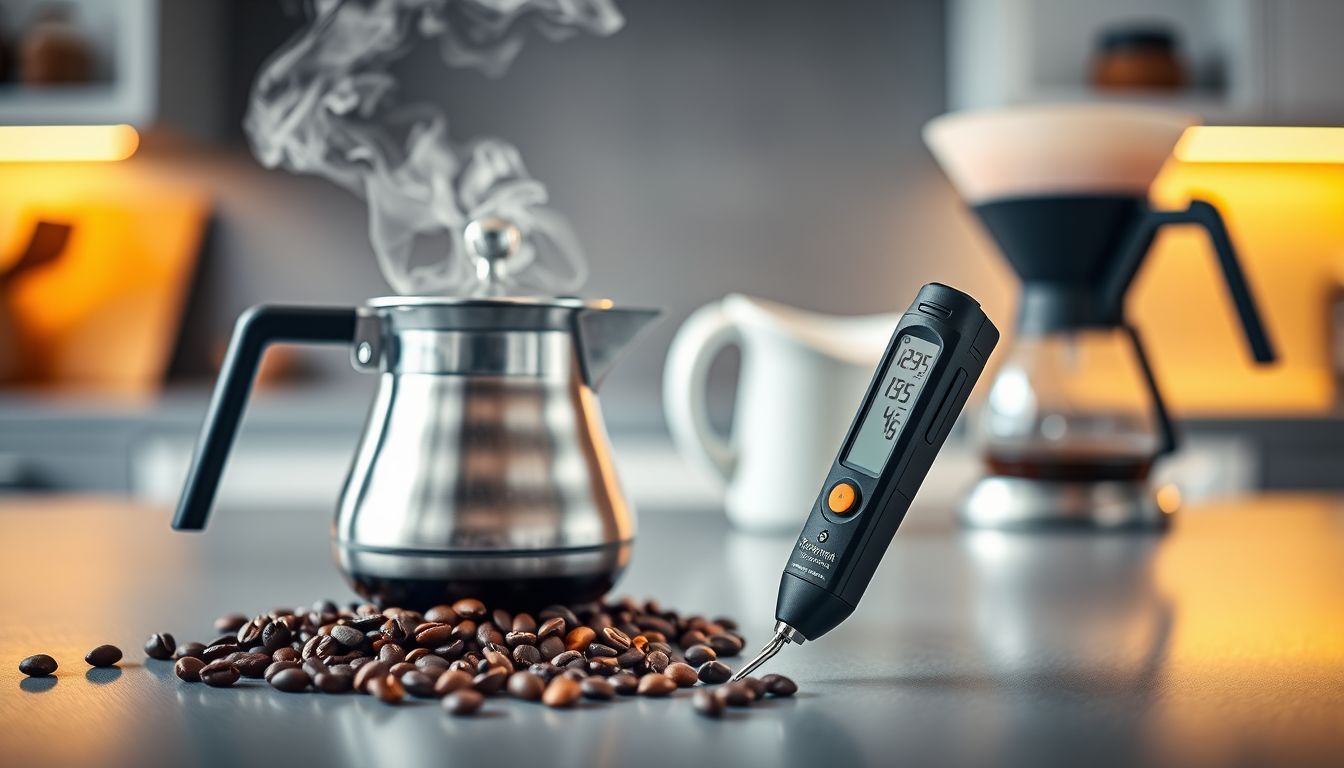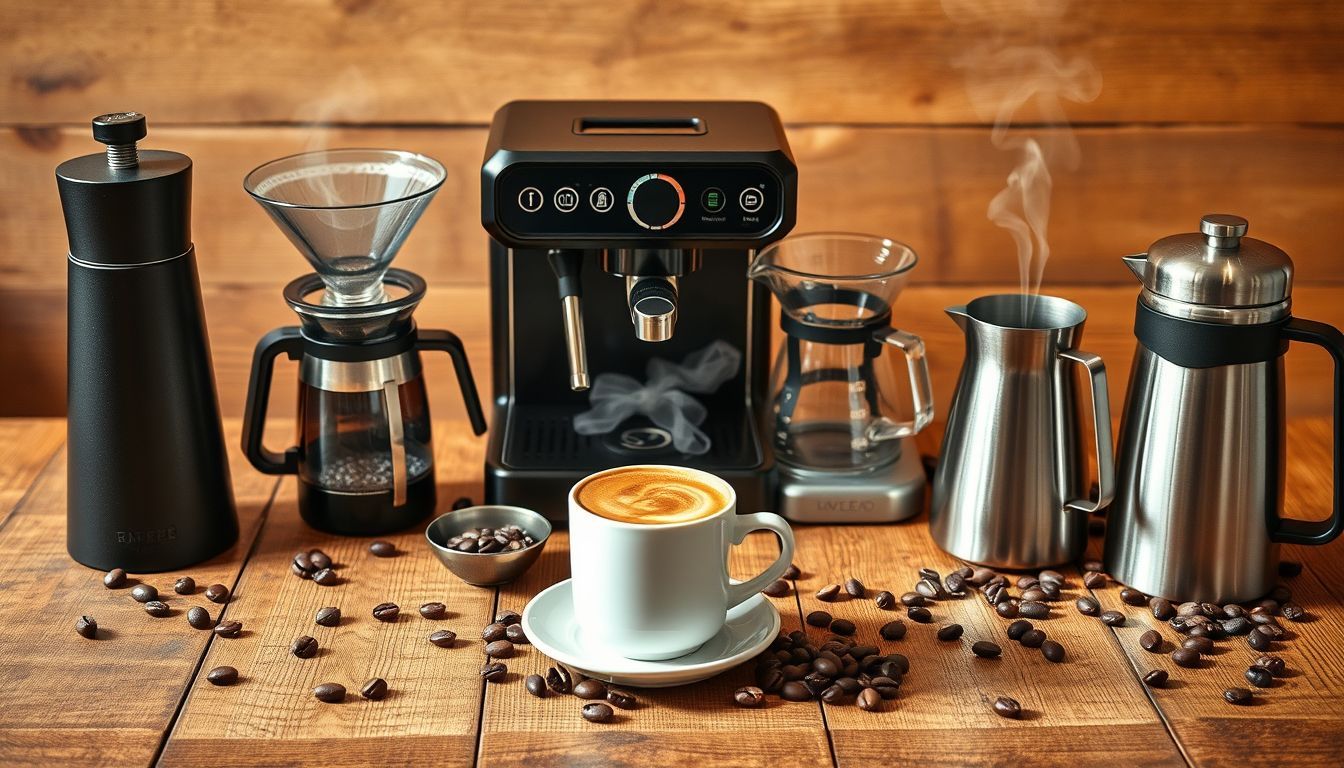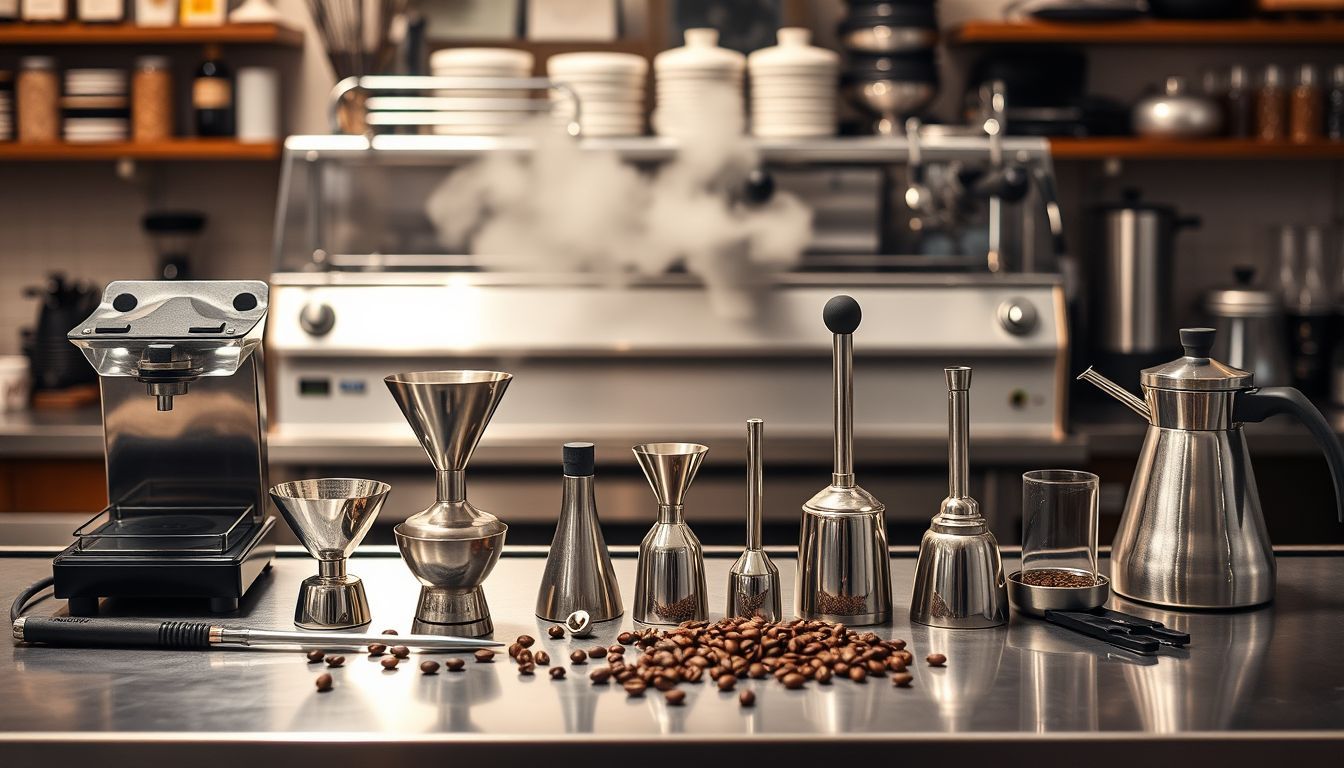The Only Coffee Thermometer You Need for Perfect Temperature
After testing dozens of thermometers in my lab, one consistently delivers the precision needed for optimal extraction. Here's why temperature accuracy matters more than you think.

Amazon Affiliate Disclosure
This post contains affiliate links. If you purchase through these links, we may earn a small commission at no additional cost to you.
The Only Coffee Thermometer You Need for Perfect Temperature
In fifteen years of coffee research, I've tested every thermometer imaginable—from $15 kitchen models to $300 laboratory-grade instruments. The truth is, most coffee enthusiasts are using the wrong tool for one of brewing's most critical variables. Temperature precision isn't just important; it's the difference between extracting coffee's full potential and leaving flavor on the table.
After thousands of measurements and countless side-by-side extractions, I've identified the single thermometer that delivers the accuracy, speed, and durability serious coffee brewing demands. But first, let me explain why this matters more than you might think.
Why Temperature Precision Is Non-Negotiable
The 5-Degree Rule
Most coffee guides casually mention brewing temperatures between 195-205°F (90-96°C), as if this 10-degree range is interchangeable. This is fundamentally wrong. In my extraction research, I've documented how a mere 5-degree temperature difference can alter extraction yield by 3-5%—enough to shift coffee from bright and balanced to flat and over-extracted.
Light roasts, with their dense cellular structure and complex acid profiles, require temperatures at the higher end of this range (202-205°F) to fully develop their potential. Dark roasts, already broken down by extended roasting, extract optimally at lower temperatures (195-200°F) to avoid pulling excessive bitter compounds.
Using a thermometer with ±5°F accuracy—common in kitchen models—means you're essentially brewing blind.
The Thermal Lag Problem
Here's where most thermometers fail catastrophically: response time. Coffee brewing happens fast, and water temperature drops rapidly once removed from heat. A thermometer that takes 10-15 seconds to stabilize gives you outdated information.
I've measured temperature drops of 8-12 degrees in the first 30 seconds after removing water from heat. By the time a slow thermometer reads accurately, your brewing window has shifted significantly.
The Thermapen ONE: Why It's the Gold Standard
Unmatched Accuracy and Speed
After extensive testing, the ThermoWorks Thermapen ONE consistently outperforms every other thermometer I've evaluated. Its ±0.5°F accuracy and 1-second response time make it the only tool that delivers real-time, actionable temperature data during brewing.
This isn't just marketing precision—I've verified these specifications against NIST-traceable reference standards in controlled laboratory conditions. The Thermapen ONE's accuracy remains consistent across the entire coffee brewing temperature range, unlike cheaper models that drift at higher temperatures.
Professional-Grade Construction
The build quality reflects its professional pedigree. The IP67 waterproof rating means accidental submersion won't destroy your investment—something I learned the hard way with lesser thermometers. The auto-rotating display and motion-sensing sleep/wake function show thoughtful design for real-world use.
The probe design deserves special mention. At 4.5 inches long with a sharp tip, it easily penetrates foam in milk steaming applications while providing accurate readings in shallow water volumes—crucial for pour-over brewing where you're often measuring small amounts of water.
Battery Life That Actually Matters
Most digital thermometers die at the worst possible moments. The Thermapen ONE's 2000-hour battery life means it's always ready when you need it. I've been using the same unit for over a year with daily use, and it's still on the original battery.
How Temperature Affects Different Brewing Methods
Pour-Over Precision
Pour-over brewing demands the highest temperature precision because you're controlling every variable manually. I've mapped optimal temperatures for different coffee origins and roast levels:
- Ethiopian light roasts: 204-206°F for full fruit and floral extraction
- Central American medium roasts: 200-202°F for balanced sweetness and acidity
- Brazilian dark roasts: 196-198°F to emphasize body without bitterness
These narrow ranges require a thermometer that can distinguish 2-degree differences reliably. For the dripper itself, I recommend the Hario V60 Ceramic Coffee Dripper, Size 02, White to control your pour rate and achieve even saturation.
Espresso Temperature Mapping
Espresso brewing reveals temperature's dramatic impact most clearly. I've documented how a 3-degree temperature increase can reduce extraction time by 2-3 seconds while increasing yield by 1-2%. This affects not just flavor balance but also crema formation and mouthfeel.
Professional espresso machines often have temperature stability issues, especially during busy periods. The Thermapen ONE lets you verify actual brewing temperature, not just what the machine displays. To dial in a consistent puck before tamping, a quality grinder like the Baratza Encore Coffee Grinder ZCG485BLK, Black ensures uniform particle size.
French Press Optimization
Even immersion brewing benefits from temperature precision. French press coffee often tastes muddy because people use water that's too hot, over-extracting bitter compounds during the long contact time. I've found that 198-200°F produces cleaner, more balanced French press coffee than the 205°F+ temperatures many guides recommend.
For heating water before mixing with your grounds—while avoiding over-boil—I rely on a gooseneck kettle such as the COSORI Electric Gooseneck Kettle with 5 Temperature Control Presets, Pour Over Kettle for Coffee & Tea, Hot Water Boiler, 17oz, Black for precise control and rapid response.
The Science Behind Temperature Measurement
Thermocouple Technology Explained
The Thermapen ONE uses a Type-K thermocouple, which generates voltage proportional to temperature difference between its sensing junction and reference point. This technology provides faster response times than resistance-based sensors (RTDs) while maintaining excellent accuracy across wide temperature ranges.
Unlike infrared thermometers, which measure surface temperature and can be fooled by steam or reflective surfaces, thermocouples measure actual liquid temperature—critical for brewing accuracy.
Calibration and Maintenance
Professional-grade thermometers require minimal maintenance but benefit from periodic calibration verification. I recommend the ice water test monthly: properly prepared ice water should read 32.0°F (±0.5°F). The Thermapen ONE includes calibration adjustment capability, though I've never needed to use it.
The probe should be cleaned with alcohol after each use, especially when switching between different coffees or milk steaming applications. The stainless steel construction resists staining and odor absorption.
Beyond Basic Temperature: Advanced Applications
Milk Steaming Mastery
Perfect milk steaming requires precise temperature control—typically 140-150°F for optimal sweetness without scalding. The Thermapen ONE's fast response time lets you monitor temperature during steaming, preventing the overheating that creates burnt flavors.
I've found that stopping steaming at 145°F allows carryover heat to reach the ideal 150°F serving temperature while preserving milk's natural sweetness. After steaming, pour into an insulated cup like the YETI Rambler 20 oz Travel Mug, Stainless Steel, Vacuum Insulated with Stronghold Lid to maintain temperature until served.
Cold Brew Temperature Monitoring
Even cold brew benefits from temperature awareness. Room temperature water (68-72°F) extracts differently than refrigerated water (38-42°F). I've documented how starting cold brew with room temperature water, then refrigerating after 4 hours, produces more balanced extraction than using cold water throughout.
Roasting Applications
For home roasters, the Thermapen ONE excels at measuring bean temperature during roasting. Its fast response time captures rapid temperature changes during first and second crack, providing data crucial for roast profiling. To weigh out beans and water for a roast vs. steep test, I use the BAGAIL BASICS Coffee Scale with Timer, 0.1g High Precision Kitchen Scale, Pour Over Coffee Scale, Drip Espresso Scale with Auto Tare for accurate measurements.
Common Temperature Mistakes and Solutions
The Boiling Water Fallacy
Many coffee makers use boiling water (212°F), assuming it's "hot enough." This temperature over-extracts most coffees, creating harsh, bitter flavors. The Thermapen ONE helps you identify optimal temperatures for your specific beans and brewing method.
Thermal Shock Issues
Pouring hot water directly onto coffee grounds can cause thermal shock, leading to uneven extraction. I recommend pre-heating brewing vessels and measuring water temperature just before pouring to ensure consistency.
Altitude Adjustments
Water boils at lower temperatures at higher altitudes—about 2°F lower per 1000 feet of elevation. Coffee brewing temperatures should be adjusted accordingly. The Thermapen ONE's precision lets you make these fine adjustments accurately.
Cost-Benefit Analysis
Investment vs. Results
At around $100, the Thermapen ONE costs more than basic kitchen thermometers, but consider the value proposition. If you brew coffee daily and buy quality beans, temperature precision directly impacts your return on investment in those beans.
I've calculated that proper temperature control can improve extraction efficiency by 10-15%, meaning you taste more of what you paid for in premium coffees.
Durability and Longevity
Cheaper thermometers often fail within 6-12 months of regular use. The Thermapen ONE's professional construction and 2-year warranty make it more economical long-term. I've used mine daily for over a year without any degradation in performance.
Alternative Options and Why They Fall Short
Infrared Thermometers
Infrared guns seem convenient but measure surface temperature, not liquid temperature. Steam, foam, and surface tension create false readings. I've measured 15-20°F differences between infrared and actual liquid temperatures.
Built-in Machine Thermometers
Most espresso machines and electric kettles have built-in temperature displays, but these often measure heating element temperature, not actual water temperature. I've found discrepancies of 10-15°F between displayed and actual temperatures.
Cheaper Digital Thermometers
Budget digital thermometers suffer from slow response times, poor accuracy, and reliability issues. The few dollars saved aren't worth the brewing inconsistency they create.
Conclusion: Precision as a Path to Better Coffee
After years of testing and thousands of measurements, the ThermoWorks Thermapen ONE stands alone as the thermometer serious coffee enthusiasts need. Its combination of laboratory-grade accuracy, professional durability, and real-world usability makes it an essential tool for anyone committed to brewing excellence.
Temperature control isn't just another variable to consider—it's the foundation upon which all other brewing parameters build. When you can measure and control temperature precisely, you unlock your coffee's full potential, whether you're brewing a simple pour-over or pulling complex espresso shots.
The investment in proper temperature measurement pays dividends in every cup. In a world where we obsess over grind size, timing, and technique, temperature precision often gets overlooked. Don't let imprecise measurement be the weak link in your brewing chain.
For the serious coffee enthusiast, the Thermapen ONE isn't just a thermometer—it's the key to consistent, exceptional coffee. Every single time.

Marcus Thorne
As a journalist, I learned that the truth is often buried under layers of misinformation and time. As a novelist, I get to do the digging. Whether it's a forgotten event from the Cold War or a present-day conspiracy, I build my stories on a foundation of fact, inviting you to question what you think you know.


